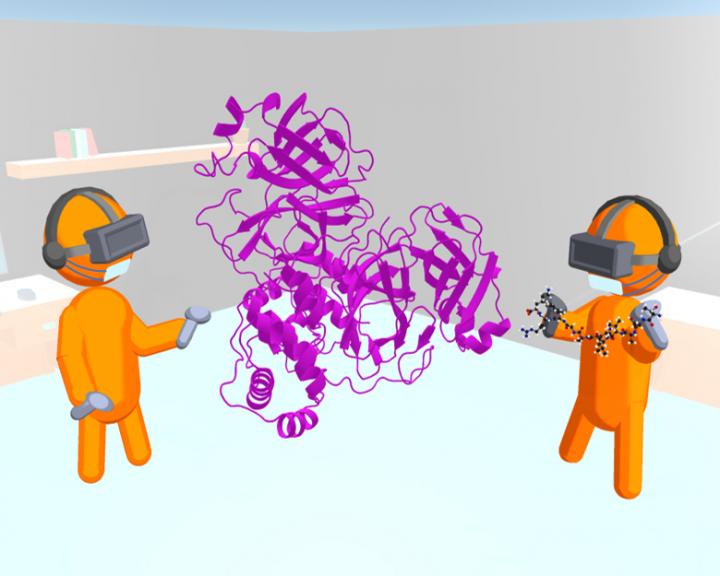
Credit: University of Bristol
Bristol scientists have demonstrated a new virtual reality [VR] technique which should help in developing drugs against the SARS-CoV-2 virus – and enable researchers to share models and collaborate in new ways. The innovative tool, created by University of Bristol researchers, and published in the Journal of Chemical Information and Modeling, will help scientists around the world identify anti-viral drug leads more rapidly.
A SARS-CoV-2 enzyme known as the main protease (Mpro) is a promising target in the search for new anti-viral treatments. Molecules that stop the main protease from working – called enzyme inhibitors – stop the virus reproducing, and so could be effective drugs. Researchers across the world are working to find such molecules. A key predictor of a drug’s effectiveness is how tightly it binds to its target; knowing how a drug fits into the protein helps researchers design changes to its structure to make it bind more tightly.
Professor Adrian Mulholland from Bristol’s School of Chemistry and the study’s lead author explained: “We’ve shown that interactive virtual reality can model how viral proteins and inhibitors bind to the enzyme. Researchers can use this tool to help understand how the enzyme works, and also to see how potential drugs fit into the enzyme. This should help design and test new potential drug leads. We are sharing these models with the whole community.”
The Bristol team have developed a virtual framework for interactive ‘molecular dynamics’ simulations. It is an open source software framework, called Narupa, which uses readily available VR equipment.
In this study, the Bristol team created a 3D model structure of the SARS-CoV-2 Mpro and used interactive molecular dynamics simulations in VR (iMD-VR) to ‘step inside’ it and visualise molecules binding to the enzyme, in atomic detail. Results showed that users were able to show how a drug molecule fits within the enzyme.
Professor Mulholland added: “There are currently many efforts globally aimed at identifying drug leads for COVID-19. Our iMD-VR tools will be a valuable resource, enabling virtual collaboration for the international drug discovery community, helping to predict how potential drug leads bind to SARS-CoV-2 targets. An exciting aspect is that it also allows researchers to collaborate in new ways: using cloud computing, they can tackle a drug discovery problem together at the same time when in they are in different locations – potentially even in different countries – working simultaneously in the same virtual molecular environment.”
“Computational modelling of how drugs bind to the SARS-CoV-2 spike protein has been critical in advancing the global fight against the pandemic. Narupa takes that modelling to an entirely new level with molecular dynamics simulations in virtual reality,” said Alison Derbenwick Miller, Vice President, Oracle for Research. “We are delighted that Oracle’s high-performance cloud infrastructure supported the development of this innovative framework, and is now helping to advance globally-connected efforts to defeat COVID-19. Growing a connected community of cloud-powered researchers is exactly what Oracle for Research was designed to do.”
###
The study was supported by grants from the EPSRC, the Royal Society and the British Society for Antimicrobial Chemotherapy. Cloud credits were provided by Oracle for Research.
Paper
‘Interactive molecular dynamics in virtual reality (iMD-VR) is an effective tool for flexible substrate and inhibitor docking to the SARS-CoV-2 main protease’ by A Mulholland et al in the Journal of Chemical Information and Modeling
Media Contact
Joanne Fryer, University of Bristol
[email protected]
Related Journal Article
http://dx.




